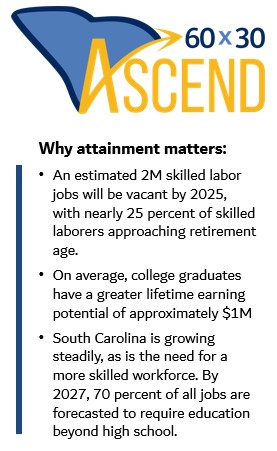
South Carolina's economy is growing steadily, and with this growth comes the demand for a more skilled workforce. With this in mind, the South Carolina Commission on Higher Education approved a statewide public agenda for higher education in 2017 which identifed a broad set of aspirational goals and objectives for the state’s system of higher education. The resulting Public Agenda Implementation Plan, Ascend 60x30, serves a strategic blueprint to guide Commissioners and CHE staff.
The Big Goals
 Two overarching objectives provide form and structure in the pursuit of the Public Agenda. The first: increase the proportion of South Carolinians with high-quality postsecondary credentials to 60 percent by 2030. South Carolina’s education attainment rate was 46.8 percent in 2020, nationally ranking 42nd and below the 51.3 percent national average, according to the Lumina Foundation’s annual report on national educational attainment. High-quality credentials provide clear pathways to further education, employment, or both.
Two overarching objectives provide form and structure in the pursuit of the Public Agenda. The first: increase the proportion of South Carolinians with high-quality postsecondary credentials to 60 percent by 2030. South Carolina’s education attainment rate was 46.8 percent in 2020, nationally ranking 42nd and below the 51.3 percent national average, according to the Lumina Foundation’s annual report on national educational attainment. High-quality credentials provide clear pathways to further education, employment, or both.
The second significant objective, closing socioeconomic educational achievement gaps, is fundamental to increasing educational attainment and is the only way to reach the 60 percent goal by 2030. Closing achievement gaps in higher education has a simple premise: one’s life circumstances should not dictate one’s chances of success.
The following activities support the CHE in pursuit of specific facets of Ascend 60x30:
- Ensuring Accessibility and Affordability: To reach the 60 percent attainment mark, the CHE collaborates with its partners to ensure all South Carolinians have both access and the means to complete a postsecondary credential through state financial aid appropriations, scholarships, and outreach events such as College Goal SC, College Application Month, and College and Career Decision Day.
- Reducing Costs: To reduce overall costs in higher education, the CHE supports initiatives to reduce textbook costs such as the Partnership Among South Carolina Academic Libraries (PASCAL), pursues systemic cost savings across higher education, and emphasizes on-time degree completion and increase early college opportunities.
- Improving Career and College Readiness: Students who are well-prepared for postsecondary education, both academically and emotionally, have high completion rates. The CHE collaborates with the State Department of Education and high school counselors across the state to improve career and college readiness.
- Comprehensive Statewide Transfer and Articulation Agreements: Ensuring earned academic credits transfer as equivalents promotes student success and reduces time to degree. The CHE, in collaboration with the state’s institutions of higher education, develops a comprehensive statewide transfer and articulation framework and agreement to ensure transferable credit toward degree completion in programs of study at South Carolina institutions. Learn more about our efforts to strengthen our state system of transfer at our Transfer Excellence Center.
- Engaging Near Completers: A major component in obtaining the 60 percent attainment goal is to engage with adults who are near the completion of a credential. In South Carolina there are nearly 450,000 people who have some college credits but no credential. The CHE assists near completers in their pursuit of postsecondary credentials by creating and sharing a clearinghouse of best practice strategies for initiatives that support the needs of adult learners.
- Strengthening the Workforce: One purpose of postsecondary education is to drive economic stability by strengthening the state’s workforce. A key pillar of the CHE’s pursuit of the Public Agenda is to expand on existing work and find new ways to meet this purpose. Much of the work required for this goal is outside the direct responsibility and purview of the CHE. The approach will focus on collaboration and coordination with external stakeholders. The work is crucial, however, and the CHE seeks to be engaged fully. Learn more about the Nursing Initiative which was created by the South Carolina General assembly to increase the number of qualified nursing educators in higher education through tuition reimbursement programs while also retaining current faculty through salary supplements.

